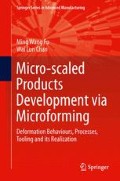Abstract
Similar to macroforming processes, meso- and micro-scaled plastic deformation or mesoforming and microforming can also have forming defects. Flow-induced defect is a common defect in the metal forming parts fabricated by mesoforming and microforming processes.
Access this chapter
Tax calculation will be finalised at checkout
Purchases are for personal use only
References
Kobayashi S, Oh S-I, Altan T (1989) Metal forming and the finite-element method. In: Oxford series on advanced manufacturing, vol 17. Oxford University Press, New York, p 377
Fu MW, Yong MS, Tong KK, Danno A (2008) Design solution evaluation for metal forming product development. Int J Adv Manuf Technol 38(3–4):249–257
Cai J, Dean TA, Hu ZM (2004) Alternative die designs in net-shape forging of gears. J Mater Process Technol 150(1–2):48–55
Jirathearanat S, Hartl C, Altan T (2004) Hydroforming of Y-shapes—product and process design using FEA simulation and experiments. J Mater Process Technol 146(1):124–129
Liu Y, Peng X, Qin Y (2004) FE simulation for concurrent design and manufacture of automotive sheet-metal parts. J Mater Process Technol 150(1–2):145–150
Gantar G, Kuzman K, Makarovic M (2004) An industrial example of FE supported development of a new product. J Mater Process Technol 150(1–2):163–169
Bariani PF, Bruschi S, Dal Negro T (2004) Integrating physical and numerical simulation techniques to design the hot forging process of stainless steel turbine blades. Int J Mach Tools Manuf 44(9):945–951
Hartley P, Pillinger I (2006) Numerical simulation of the forging process. Comput Methods Appl Mech Eng 195(48–49):6676–6690
Bariani PF, Dal Negro T, Bruschi S (2004) Testing and modelling of material response to deformation in bulk metal forming. CIRP Ann-Manuf Technol 53(2):573–595
Datta AK, Das G, De PK, Ramachandrarao P, Mukhopadhyaya M (2006) Finite element modeling of rolling process and optimization of process parameter. Mater Sci Eng Struct Mater Prop Microstruct Process 426(1–2):11–20
Fu MW, Yong MS, Muramatsu T (2008) Die fatigue life design and assessment via CAE simulation. Int J Adv Manuf Technol 35(9–10):843–851
Fu MW, Lu J, Chan WL (2009) Die fatigue life improvement through the rational design of metal-forming system. J Mater Process Technol 209(2):1074–1084
Chan WL, Fu MW, Lu J, Chan LC (2009) Simulation-enabled study of folding defect formation and avoidance in axisymmetrical flanged components. J Mater Process Technol 209(11):5077–5086
Chan WL, Fu MW, Lu J (2010) FE simulation-based folding defect prediction and avoidance in forging of axially symmetrical flanged components. J Manuf Sci Eng -Trans ASME 132(5)
Fu MW, Yong MS, Tong KK, Muramatsu T (2006) A methodology for evaluation of metal forming system design and performance via CAE simulation. Int J Prod Res 44(6):1075–1092
Wang JL, Fu MW, Ran JQ (2013) Analysis and avoidance of flow-induced defects in meso-forming process: simulation and experiment. Int J Adv Manuf Technol 68(5–8):1551–1564
Author information
Authors and Affiliations
Corresponding author
Rights and permissions
Copyright information
© 2014 Springer-Verlag London
About this chapter
Cite this chapter
Fu, M.W., Chan, W.L. (2014). Flow-Induced Defects in Mesoforming Processes. In: Micro-scaled Products Development via Microforming. Springer Series in Advanced Manufacturing. Springer, London. https://doi.org/10.1007/978-1-4471-6326-8_5
Download citation
DOI: https://doi.org/10.1007/978-1-4471-6326-8_5
Published:
Publisher Name: Springer, London
Print ISBN: 978-1-4471-6325-1
Online ISBN: 978-1-4471-6326-8
eBook Packages: EngineeringEngineering (R0)

